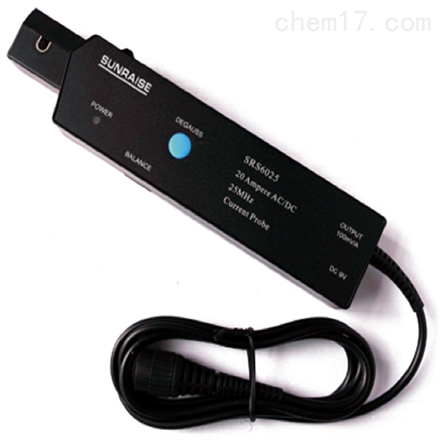The oscilloscope current probe achieves accurate measurement of the current signal by testing the magnetic field signal generated by the current. Mainly used for measurement and analysis of conductor current. There are many types of current probes. The applications of this series of products are similar to those of current probes. They are both suitable for the measurement and analysis of current data in high-frequency situations. It is widely used. Its basic principle is that the current flowing through the wire will generate a magnetic field around it. It converts the magnetic field into a corresponding voltage signal. By cooperating with an oscilloscope, the corresponding current waveform can be observed. It is widely used in switching power supply, motor driver, electronic rectifier, new energy and other fields.
Classification of oscilloscope current probes:
Oscilloscope probes can be divided into passive probes and active probes according to whether power supply is required. According to the signal type to be measured, they can be divided into voltage probes, current probes, optical probes, etc. The so-called passive probe means that the entire probe is composed of passive components, including resistors, capacitors, cables, etc.; active probes generally have amplifiers inside, and the amplifiers need to be powered, so they are called active probes. The input impedance of high-impedance passive probes in oscilloscopes is high, but the bandwidth is not high. The bandwidth of low-impedance passive probes can be high, but the input impedance is not high.
The disadvantage of passive probes is that they cannot measure DC models, and the low-frequency cutoff point is usually above 100Hz. The advantage is low cost. Passive AC probes can be divided into split core and solid core according to the embedded head structure. The split-core insert can be opened and closed manually. The advantage is that the probe can be easily stuck on the conductor for measuring current. When the measurement is completed, the jaws can be opened and the probe can be moved to other conductors.
Active probes are divided into two types according to the common forms of jaws: one is an ordinary embedded structure, and the other is a flexible structure. Ordinary embedded structure current probes generally use iron cores made of strong magnetic materials. When such a large primary current flows, the iron core is prone to magnetic saturation, making accurate measurements impossible; while flexible probes use hollow cores. Type AC current sensor, so it is not saturated even under large current conditions, so flexible probes are generally used to measure large currents, and can only measure AC.

Previous article:Principle of differential amplification of high voltage differential probe
Next article:Safe use and maintenance methods for high-voltage differential probes
- Popular Resources
- Popular amplifiers
- Seizing the Opportunities in the Chinese Application Market: NI's Challenges and Answers
- Tektronix Launches Breakthrough Power Measurement Tools to Accelerate Innovation as Global Electrification Accelerates
- Not all oscilloscopes are created equal: Why ADCs and low noise floor matter
- Enable TekHSI high-speed interface function to accelerate the remote transmission of waveform data
- How to measure the quality of soft start thyristor
- How to use a multimeter to judge whether a soft starter is good or bad
- What are the advantages and disadvantages of non-contact temperature sensors?
- In what situations are non-contact temperature sensors widely used?
- How non-contact temperature sensors measure internal temperature
- LED chemical incompatibility test to see which chemicals LEDs can be used with
- Application of ARM9 hardware coprocessor on WinCE embedded motherboard
- What are the key points for selecting rotor flowmeter?
- LM317 high power charger circuit
- A brief analysis of Embest's application and development of embedded medical devices
- Single-phase RC protection circuit
- stm32 PVD programmable voltage monitor
- Introduction and measurement of edge trigger and level trigger of 51 single chip microcomputer
- Improved design of Linux system software shell protection technology
- What to do if the ABB robot protection device stops
- CGD and Qorvo to jointly revolutionize motor control solutions
- CGD and Qorvo to jointly revolutionize motor control solutions
- Keysight Technologies FieldFox handheld analyzer with VDI spread spectrum module to achieve millimeter wave analysis function
- Infineon's PASCO2V15 XENSIV PAS CO2 5V Sensor Now Available at Mouser for Accurate CO2 Level Measurement
- Advanced gameplay, Harting takes your PCB board connection to a new level!
- Advanced gameplay, Harting takes your PCB board connection to a new level!
- A new chapter in Great Wall Motors R&D: solid-state battery technology leads the future
- Naxin Micro provides full-scenario GaN driver IC solutions
- Interpreting Huawei’s new solid-state battery patent, will it challenge CATL in 2030?
- Are pure electric/plug-in hybrid vehicles going crazy? A Chinese company has launched the world's first -40℃ dischargeable hybrid battery that is not afraid of cold
- LPC4357 internal EEPROM read and write problem
- Patch Microstrip Filter Example
- [Synopsys IP Resources] CDC Verification: One of the Biggest Challenges in Multi-Billion-Gate ASIC Design
- Want to buy Dahua DH-PHSA1.2-SH and DH-PHSA1.5-SH LED modules
- Microphone sound signal extraction and processing
- 5G will change the way we surf the Internet. Will each of us have a small base station?
- [Review of SGP40] Rapid deployment of AI ambient air quality tracking model #1 Unboxing
- What is a NB-IoT card?
- [RVB2601 Creative Application Development] Part 2 Development Preparation 2 (Development Environment Setup and Helloworld Example)
- [Fudan Micro FM33LG0 Series Development Board Review] Development Environment First

 MAX4246AKA+
MAX4246AKA+
















 京公网安备 11010802033920号
京公网安备 11010802033920号